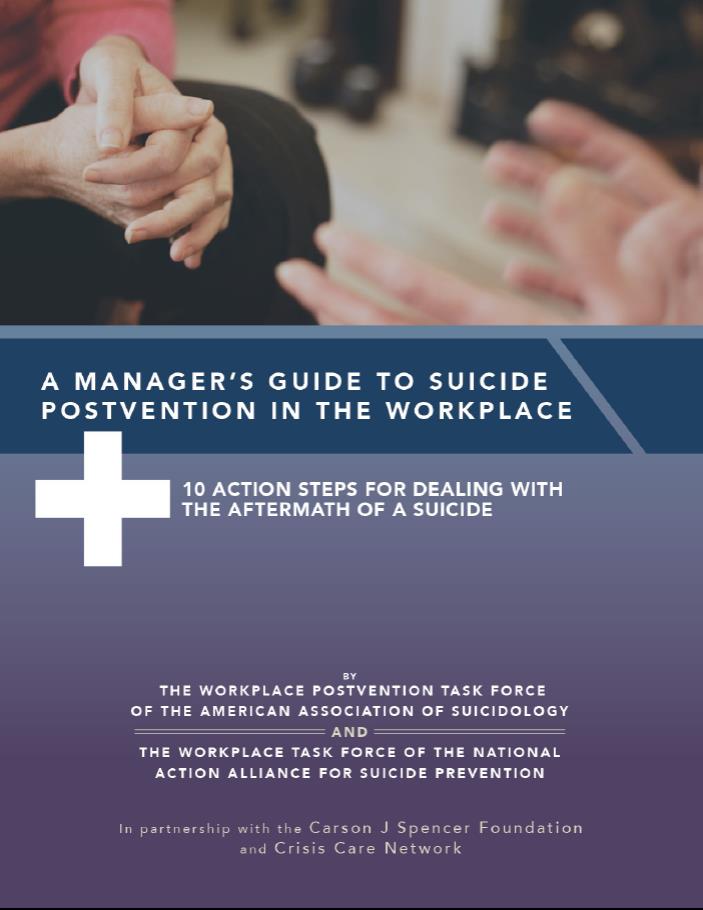See
guide at: http://carsonjspencer.org/ManagersGuidebook.pdf
In the U.S., the majority of people who take their lives are working-aged people, and yet workplaces are often unprepared to deal with this crisis. Today the American Association of Suicidology (AAS) and the National Action Alliance for Suicide Prevention (Action Alliance) announce the launch of a collaborative publication, in partnership with Crisis Care Network (CCN), and the Carson J Spencer Foundation entitled A Manager’s Guide to Suicide Postvention in the Workplace: 10 Action Steps for Dealing with the Aftermath of Suicide.
In the U.S., the majority of people who take their lives are working-aged people, and yet workplaces are often unprepared to deal with this crisis. Today the American Association of Suicidology (AAS) and the National Action Alliance for Suicide Prevention (Action Alliance) announce the launch of a collaborative publication, in partnership with Crisis Care Network (CCN), and the Carson J Spencer Foundation entitled A Manager’s Guide to Suicide Postvention in the Workplace: 10 Action Steps for Dealing with the Aftermath of Suicide.
For every suicide death, an
estimated minimum of six people are affected, resulting in approximately six
million American “survivors of suicide” in the last 25 years. The creation of
the guide came as a logical step for the collaborators. “The demographics of
suicide inform us that the working-age individual, in particular working-age
male, is most at risk for suicide,” explained Dr. Alan Berman, Executive
Director for the AAS. “A sizeable proportion of these deaths by suicide occur
on the worksite, or otherwise affect the worksite, pointing to an increased
need for postvention in the working population. These guidelines are most
important for systems of employment, in the worst case possibility that such a
tragedy occurs.”
 |
| Manager's Guide Cover |
“In many postvention responses we saw business leaders
forced to operate well outside of their training and expertise, grappling with
unanswered and unanswerable questions,” said Bob VandePol, President of CCN.
“When there is a death by suicide, all eyes turn to leadership and people take
their cues based upon how leadership responds. It’s also true that people under
the influence of traumatic stress look to leadership and make assumptions about
their own personal worth within the company, so there is tremendous power in a
calm, compassionate presence by management during this time.”
The collaborators worked to create a set of guidelines that are useful across varied types of workplaces, and they expect a range of individuals within these organizations and companies to find the information immediately helpful .“This guide can be useful to managers at all levels–from the CEO of a large business to a front-line supervisor of a small organization,” asserted Action Alliance Executive Secretary, Dr. David Litts. The Action Alliance played a key role in bringing these groups together to develop this resource.
To download your own copy of
these guidelines and to review others, please go to http://carsonjspencer.org/ManagersGuidebook.pdf.
American Association of Suicidology
Founded in 1968, AAS
is a membership organization for all those involved in suicide prevention and
intervention, or touched by suicide. AAS leads the advancement of scientific
and programmatic efforts in suicide prevention through research, education and
training, the development of standards and resources, and survivor support
services.
Contact: Alan L. Berman, PhD, ABPP, Executive
Director, 202-237-2280, berman@suicidology.org
National Action
Alliance for Suicide Prevention
The National Action Alliance
for Suicide Prevention, a public-private coalition, works to advance the National Strategy for Suicide Prevention
by championing suicide prevention as a national priority, catalyzing efforts to
implement high priority objectives of the National
Strategy, and cultivating the resources needed to sustain progress.
Launched in 2010 by Health and Human Services Secretary Kathleen Sebelius and
former Defense Secretary Robert Gates, the Action Alliance envisions a nation
free from the tragic event of suicide. For more information, see www.actionallianceforsuicideprevention.org.
Contact: Katie Deal, Deputy Secretary, 202-572-3722,
kdeal@edc.org
The Carson J Spencer
Foundation (www.CarsonJSpencer.org) is a Colorado nonprofit, established in
2005. We envision a world where leaders and communities are committed to
sustaining a passion for living. We sustain a passion for living by
·
Delivering
innovative and effective suicide prevention programs for working-aged people.
·
Coaching
young leaders to develop social enterprises for mental health promotion and
suicide prevention.
·
Supporting
people bereaved by suicide.
Contact: Sally Spencer-Thomas, PsyD, CEO &
Co-Founder, 720-244-6535, sally@carsonjspencer.org
Crisis Care Network
Founded in 1997, Crisis Care Network (CCN) is the EAP
industry’s premier provider of Critical Incident Response for the workplace.
CCN helps individuals and organizations return to work, life, and productivity
following critical incidents. We mitigate the human and financial costs of
workplace tragedy such as workers' compensation claims, low morale, employee
attrition, and litigation. CCN has established the nation's largest network of
master’s- and doctoral-level clinicians trained as Critical Incident Response
Specialists, responding more than 1,000 times per month to workplace incidents
for EAP’s, insurers, and employers in communities throughout the United States
and Canada.
Contact: Judy Beahan, MSW, Clinical Manager,
888-736-0911, Judy.Beahan@crisiscare.com
No comments:
Post a Comment